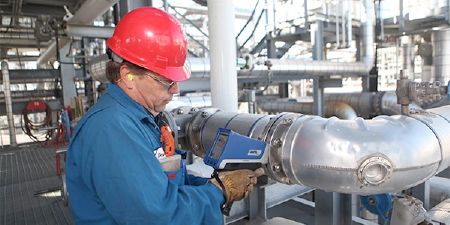This post was originally published on AZO Materials on September 27, 2016.
Alex Thurston, alloy applications specialist for portable XRF at Olympus, talks to Stuart Milne at AZoM about the Vanta™ handheld XRF analyzer and its powerful capabilities in industrial environments.
SM: Alloy analysis is important in many industries ranging from aerospace testing and pipeline analysis to scrap sorting and welding. What sets the Vanta analyzer apart from other handheld XRF devices currently on the market?
AT: Olympus’ Vanta analyzer has numerous improvements that positively affect alloy testing and sorting.
First, it has been designed from the ground up to withstand the rigors of industrial environments for maximum uptime, faster ROI, and a lower cost of ownership. This includes drop testing to U.S. Military Standards (MIL-STD-810G) and a rating of IP55* for protection against dust and water ingress.
In addition to the rugged design, our new Axon Technology™ is a major leap forward in handheld XRF analytical performance. Axon Technology utilizes ultra-low-noise electronics to increase the resolution capability of the instrument, yielding accurate elemental detection in hard-to-determine energy regions. Software advancements have enabled a greater throughput of X-rays that can be counted, which improves the precision displayed to a user. And ultimately, increased precision means users can have greater confidence in their results.
SM: What features make Vanta analyzers better than other available devices for predicting possible in-service corrosion?
AT: In-service corrosion monitoring via handheld (HH) XRF is frequently concerned with two critical factors: computation of alloyed transition metals and silicon content. The Vanta analyzer excels at accurately quantifying these critical elements, especially in the spectrally-crowded transition metal region, such as chromium, nickel, and copper. Detecting light elements, like silicon, has benefitted greatly from a large increase in signal counts and increased resolution, providing better separation and more defined light element spectral peaks.
SM: How has the Vanta analyzer been developed to make the crowded iron-nickel-cobalt (Fe-Ni-Co) and magnesium-aluminum-silicon (Mg-Al-Si) regions easier to analyze?
AT: These are two unique aspects to spectral processing, especially for alloy identification. One is a very high signal and background region with several spectral overlaps (Fe-Ni-Co) and the other is a traditionally low count rate region that makes it difficult for analyzers to accurately quantify compositional levels less than 0.5%.
Vanta analyzers can easily quantify the Fe-Ni-Co region because of the extremely low noise and background associated with the spectral generation of the hardware and software. In addition, the increased resolution of the detector has enabled spectral processing to report much lower limits of cobalt (Co) than before due to reduced interference from the iron (Fe) peaks. The advancements of the Axon Technology have enabled us to define elemental peaks and valleys where we could not previously.
The Mg-Al-Si region has been improved with respect to the amount of representative X-rays that are generated from these elements and able to be counted as part of a useable spectra. In previous generations of handheld XRF, these elements barely generated enough signal, resulting in peaks that were not well defined. This made it difficult to accurately quantify these elements below 1000 ppm (0.1%). The Vanta analyzer, with its dramatically improved count rate, enables the instrument to precisely determine the amount of these elements present in far less time than has historically been needed.
SM: What developments have been made for increased lighter elemental analysis detection speed, and how has this resulted in greater throughput for sorting tasks?
AT: As mentioned, the count rate for these lighter element regions has been greatly increased. Due to the analyzer’s improved count rate, the display time for lighter elements is very fast. Previous HHXRF instruments displayed light element results that may not be entirely accurate on the screen to keep the user engaged — that tactic is no longer needed. Accurate results of low-Z number elements magnesium through sulfur can be quantified in just a few seconds. Reducing required testing times is the easiest way to increase throughput in sorting tasks. With the Vanta analyzer, being fast and accurate helps ensure the user’s success and confidence in sorting tasks with critical light element detection. All of these great light element analysis features are paired with robust analysis characteristics of elements with higher Z-numbers and melting points, which other handheld-based alloy identification systems may have difficulty in accurately analyzing.
SM: How is the Vanta analyzer able to offer highly precise results in QA/QC inspection activities?
AT: In addition to all of the hardware and software improvements that contribute to precise results, the Vanta analyzer has an expanded grade library to match more commonly used alloys across all bases of metals. In addition to more grades being included in the grade library, detailed grade match messages can be displayed, further informing users of overlapping grade considerations, casting-equivalency designations, and even similar chemistry characteristics of different alloys.
The combination of the grade and specification information that is available through the grade matching system coupled with the precise compositional results provide users with results they can trust when used as part of a QA/QC inspection system.
SM: How does the Vanta analyzer compare to lab-based systems?
AT: The incredible count rate that is possible the Vanta analyzer approaches many lab-based systems, all while using a lower power tube. The low-noise spectral generation possible with the Vanta analyzer affords users the flexibility of performing extremely precise testing, even when in the field.
SM: What impact does the analyzer’s improved physical envelope have on users in the field
AT: The Vanta analyzer is able to maintain all of the mentioned hardware and software improvements and still feature an IP55 rating*. Simply put, it was designed from the start for routine usage in tough environments. From drips and sprays to airborne dust, the Vanta analyzer can operate as expected with obstacles that were once considered a detriment to HHXRF operation. Other envelope design aspects were created for users wearing personal protective equipment (PPE), such as the touch-screen user interface, tactile joystick navigation capability, and a tool-less window change feature.
*M series analyzers are IP54 rated.
Related Content
3 Important Considerations when Using X-ray Fluorescence for PMI
4 Advantages of Axon Technology
Get In Touch


